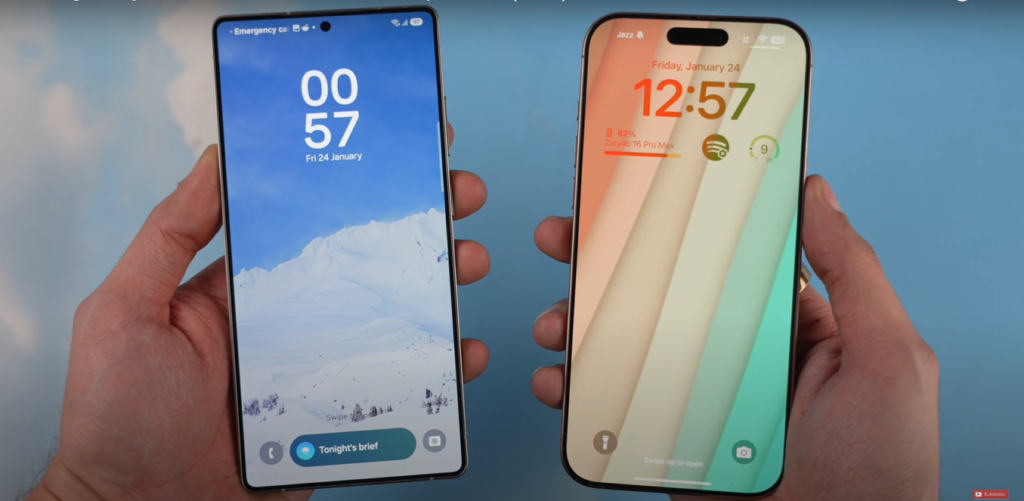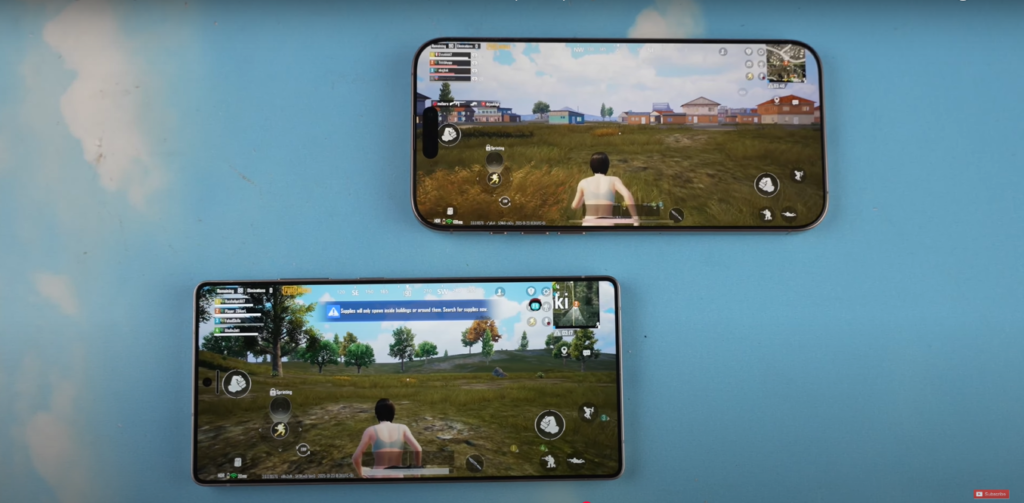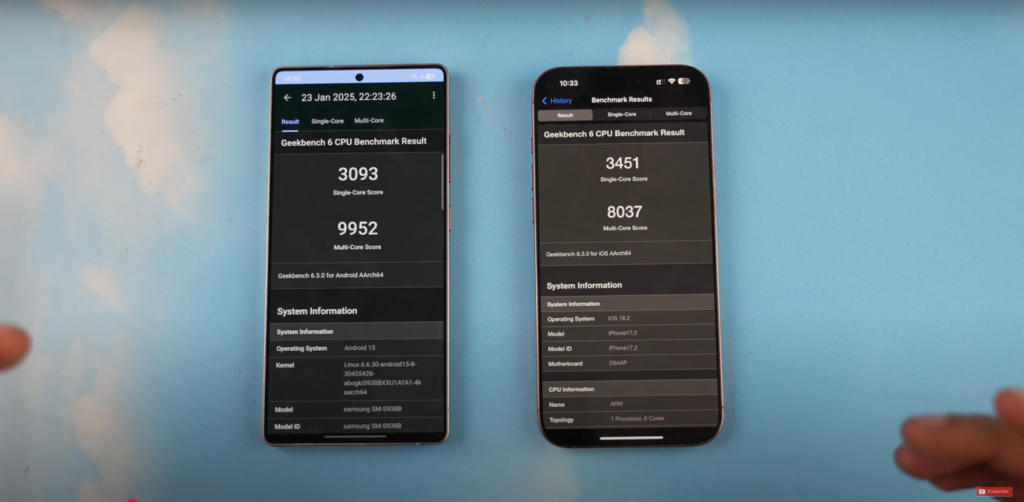Samsung Galaxy S25 Ultra vs iPhone 16 Pro Max: The Ultimate Flagship Battle
In the ever-evolving world of flagship smartphones, two giants consistently dominate the conversation: Samsung and Apple. The release of the Samsung Galaxy S25 Ultra and iPhone 16 Pro Max has once again ignited a fierce debate among tech enthusiasts and consumers alike. These devices are packed with cutting-edge technology, promising to redefine what smartphones can achieve. But which one truly deserves the crown of the ultimate flagship? Let’s dive deep into this comparison to find out.

Design and Build Quality
Samsung Galaxy S25 Ultra
The Galaxy S25 Ultra boasts a futuristic design with its curved edges and nearly bezel-less display. Samsung has refined its aesthetic, offering a titanium frame for added durability while maintaining a sleek, premium look. The back panel features a matte finish to resist fingerprints and a quad-camera setup that seamlessly integrates into the chassis.
The device is slightly larger than its predecessor but still comfortable to hold. With an IP68 rating, it’s resistant to dust and water, ensuring durability in various conditions.
iPhone 16 Pro Max
Apple’s design philosophy remains iconic, with the flat edges and Ceramic Shield front offering a blend of aesthetics and durability. The iPhone 16 Pro Max introduces lighter and stronger Grade 6 titanium, making it more robust than ever. The back houses a familiar triple-camera system, but Apple has refined the layout to make it less protruding.
Apple’s dedication to sustainability is evident, with the use of recycled materials in its construction. Like its competitor, it’s also IP68 rated for water and dust resistance.
Verdict
Both devices excel in design and build quality, but the choice concerns personal preference. Samsung’s futuristic curves cater to those who love innovation, while Apple’s classic flat design appeals to minimalists.
Display Technology
Samsung Galaxy S25 Ultra
Samsung has always been a leader in display technology, and the S25 Ultra is no exception. It features a 6.9-inch Dynamic AMOLED 2X display with a staggering 3200 x 1440 resolution and a variable refresh rate of 1Hz to 120Hz. The peak brightness hits an industry-leading 2,600 nits, making it ideal for outdoor use.
The screen supports HDR10+ and offers vibrant colors with deep blacks, making it a visual treat for media consumption and gaming. Samsung’s S-Pen integration adds another layer of functionality, allowing users to take notes and sketch with precision.

iPhone 16 Pro Max
The iPhone 16 Pro Max sports a 6.7-inch Super Retina XDR display, featuring 2796 x 1290 resolution and ProMotion technology for smooth scrolling and responsive touch. Apple’s advancements in LTPO OLED technology deliver a 1Hz to 120Hz adaptive refresh rate, ensuring efficiency and performance.
With a peak brightness of 2,500 nits, the display is slightly dimmer than Samsung’s but still excellent for outdoor visibility. Apple’s True Tone and P3 wide color support ensure accurate color reproduction.
Verdict
Samsung’s display edges ahead with its larger size, higher resolution, and superior brightness. However, Apple’s color accuracy and seamless integration with iOS offer a polished experience.
Performance
Samsung Galaxy S25 Ultra
Under the hood, the Galaxy S25 Ultra is powered by the Exynos 2500 (global variant) or Qualcomm Snapdragon 8 Gen 4 (US and select markets). These chips are built on a 3nm process and deliver unparalleled performance and energy efficiency. The device has 16GB of LPDDR5X RAM and up to 1TB of UFS 4.0 storage, ensuring smooth multitasking and blazing-fast data transfer speeds.
Samsung’s optimization of One UI 6.5 ensures a fluid user experience, leveraging AI to enhance app launches and battery performance.

iPhone 16 Pro Max
The iPhone 16 Pro Max is powered by Apple’s A18 Bionic chip, built on an advanced 3nm architecture. With a focus on AI and machine learning, the A18 offers unmatched performance in tasks like photo processing, gaming, and augmented reality. Paired with 8GB of unified memory and storage options up to 1TB, the iPhone delivers seamless performance.
Apple’s iOS 18 is optimized to take full advantage of the hardware, ensuring a cohesive and responsive user experience.
Verdict
While both devices deliver top-tier performance, Apple’s A18 Bionic chip slightly edges out in raw processing power and efficiency. However, Samsung’s higher RAM capacity and multitasking capabilities make it a powerhouse for productivity.
Camera Capabilities
Samsung Galaxy S25 Ultra
Samsung has taken mobile photography to new heights with the 200MP primary sensor, complemented by a 12MP ultra-wide lens, a 10MP periscope telephoto lens (10x optical zoom), and a 10MP telephoto lens (3x optical zoom). The device excels in low-light photography, thanks to Advanced Nightography and AI-driven noise reduction.
The 8K video recording at 30fps and improved stabilization make it a videographer’s dream. Samsung’s Pro Mode offers granular control for enthusiasts.
iPhone 16 Pro Max
Apple’s triple-camera system includes a 48MP main sensor, a 12MP ultra-wide lens, and a 12MP telephoto lens with up to 6x optical zoom. The introduction of Photonic Engine 2.0 enhances low-light performance, while Cinematic Mode now supports 4K HDR at 60fps.
The iPhone’s computational photography shines with features like Smart HDR 6 and Deep Fusion, making every shot detailed and vibrant.
Verdict
Samsung leads in zoom capabilities and resolution, while Apple’s computational photography and video features provide a superior user-friendly experience. The choice depends on whether you prioritize hardware or software-driven photography.
Battery Life and Charging
Samsung Galaxy S25 Ultra
With a 5,500mAh battery, the Galaxy S25 Ultra promises all-day battery life, even with heavy usage. Samsung’s 45W wired charging and 25W wireless charging ensure quick top-ups, while reverse wireless charging adds convenience.
iPhone 16 Pro Max
The iPhone 16 Pro Max features a 4,400mAh battery, slightly smaller than Samsung’s offering. However, Apple’s efficiency with iOS and the A18 Bionic chip ensures impressive battery life. The device supports 35W wired charging and 15W MagSafe wireless charging.
Verdict
Samsung’s larger battery and faster charging options make it the better choice for power users. However, Apple’s optimization ensures competitive endurance despite the smaller battery.
Software and Ecosystem
Samsung Galaxy S25 Ultra
The device runs on One UI 6.5, based on Android 14. Samsung’s ecosystem integrates seamlessly with Galaxy Buds, Galaxy Watch, and SmartThings. Features like DeX mode turn the phone into a desktop-like experience, enhancing productivity.
iPhone 16 Pro Max
Apple’s iOS 18 offers a seamless experience across devices, including the iPad, Mac, and Apple Watch. The tight integration between hardware and software creates a cohesive ecosystem that’s hard to beat.
Verdict
Apple’s ecosystem remains unmatched in cohesiveness, but Samsung’s versatility and customization options offer greater flexibility for Android users.
Pricing and Value
Samsung Galaxy S25 Ultra
Starting at $1,399, the Galaxy S25 Ultra offers a premium package with advanced features, making it a solid investment for those seeking the best of Android.
iPhone 16 Pro Max
The iPhone 16 Pro Max starts at $1,199, making it slightly more affordable. Apple’s strong resale value and long-term software support add to its appeal.
Verdict
The Galaxy S25 Ultra provides more bang for your buck with its additional features, while the iPhone’s value lies in its ecosystem and long-term support.
——————————————————–
Both the Samsung Galaxy S25 Ultra and iPhone 16 Pro Max are exceptional devices that cater to different audiences. The Galaxy S25 Ultra shines with its display, camera versatility, and productivity features, making it ideal for power users. On the other hand, the iPhone 16 Pro Max offers unmatched performance, a cohesive ecosystem, and intuitive software, appealing to those who value simplicity and efficiency.
Ultimately, the choice between these two titans boils down to personal preference and ecosystem loyalty. Whether you’re Team Android or Team iOS, both devices represent the pinnacle of smartphone innovation in 2024.

